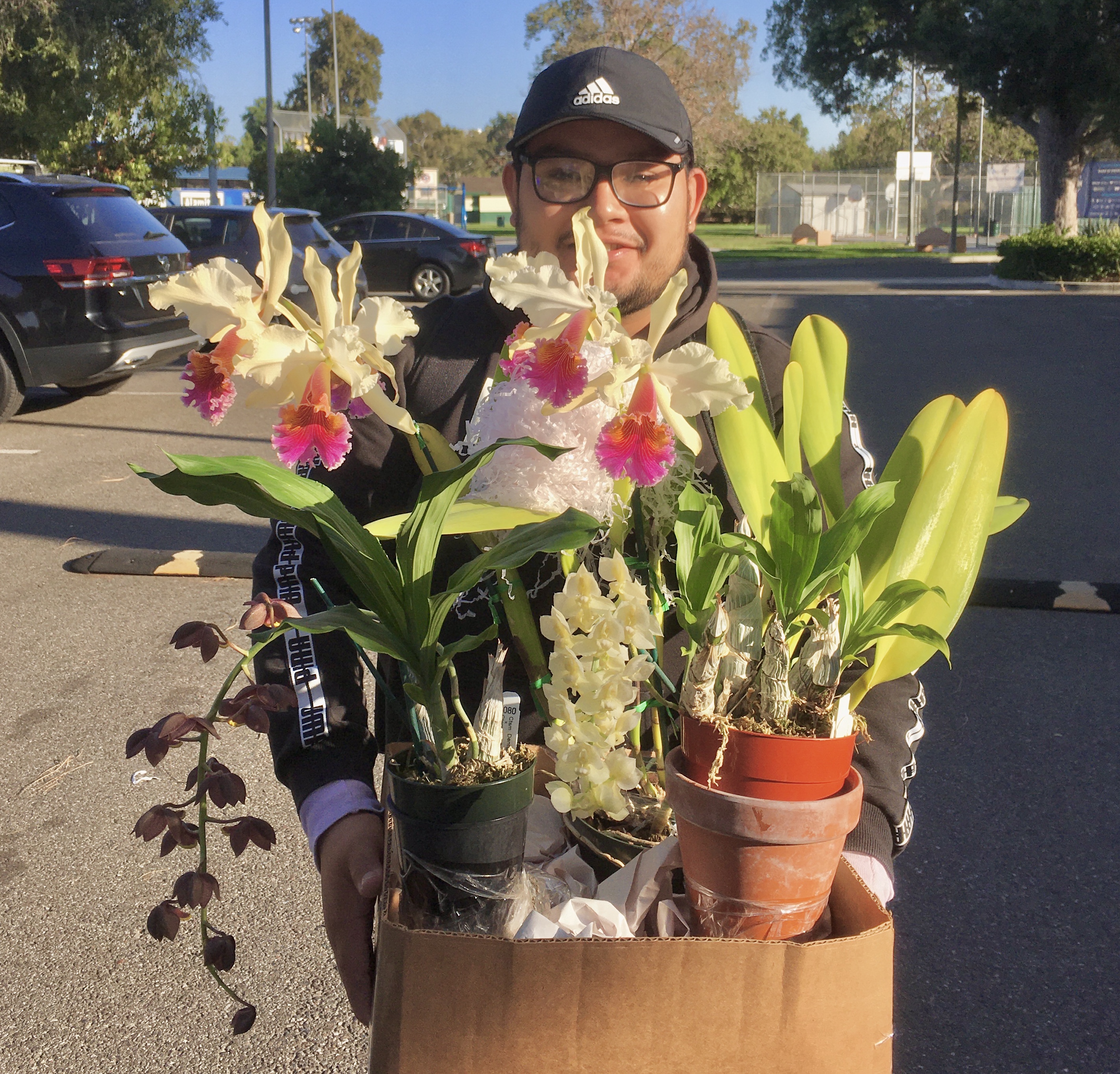
Looking around at a typical orchid club meeting, you might think orchids are only grown by old people. Not true! More likely, our younger colleagues haven't found time for club meetings, and probably don't know they are missing out on decades or even centuries of collective experience about what it takes to grow orchids successfully in our climate.
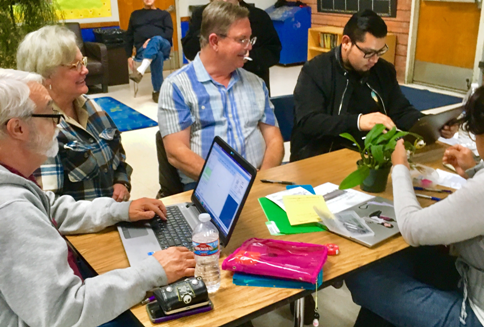
Four judges, all in a row: From left to right, Doug Overstreet, Carol Beule, Fred Clarke, and Carlos Lopez, in the back room during our meeting on January 28, 2019
A number of our orchid friends started out young and kept learning. Several are now accredited AOS judges and favorite speakers. One or two have even managed to find a career in orchids. Carlos Lopez is one of them: well on his way to becoming an AOS judge, working hard at Sunset Valley Orchids, absorbing a phenomenal amount of orchid lore, trying out plants and methods for himself — an expert by any measure.
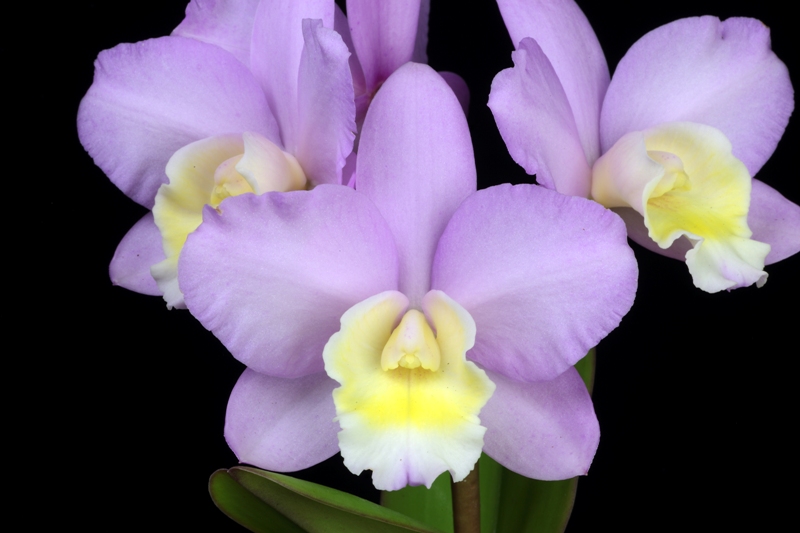
© 2018 Ramon de los Santos
Cattlianthe Sandra Laura 'Reina Oaxaqueña' AM/AOS, Carlos' first AOS award, at the Santa Barbara International Orchid Show, March 8, 2018. The flowers are just over 3" across.
Carlos has been cultivating orchids for about a decade. His orchid venture began at the age of 13 when he started to follow his father to work at Sunset Valley Orchids. Before he knew it, he was volunteering at the nursery and helping to clean orchid flasks, repot orchids, and do other small tasks. Carlos eventually became more involved in the nursery's operations and maintenance, and started to take part in attending orchid shows.
What the Fringed Lip Does — Landing Pad for a Pollinator!
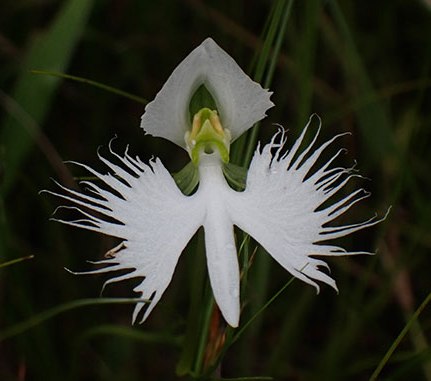
Habenaria radiata, photo provided by Kobe University in press release for the study cited here
A Japanese team recently reported an ingenious experiment, very much in the tradition of Darwin, to work out the function of the fringed lip of Habenaria (Pecteilis) radiata. The pollinator, or one of them, is a hawkmoth. In a controlled setting, the moths were presented with Habenaria flowers, either intact, or with the fringe trimmed off. Without the fringe, the moths were still attracted to the flowers. Seed set (a measure of the success of pollination) decreased when the fringe was removed. The removal of the fringe did not interfere with attracting the moths to the flowers, but it did interfere with their ability to grasp the fringe of the lip with their midlegs while drinking nectar from the flower's long spur. Lack of the stabilizing foothold, rather than a visual attraction to the fringed lip, seems to have resulted in a reduced seed set. For the delightfully clear account of the experiment and the observations, see this link from Kobe University.
Currently a Sunset Valley Orchids Greenhouse specialist, Carlos has years of experience with cattleya, catasetum, Australian dendrobiums, and sarcochilus. Carlos is currently training to become an American Orchid Society Judge and works with Orchid Digest as well.
At Sunset Valley Orchids, Carlos really enjoys the bifoliate Cattleyas, which under his care seem to get bigger every year, sometimes well over 3' tall. But he is equally at home with all groups of orchids. Whether dealing with first-time orchid buyers or experts, he knows his plants!
How did he get started with Habenaria? We'll have to wait for the full story, but it seems Carlos saw one, was intrigued, and wondered if he could grow it. The experiment was a success, and now he's ready to explain how to grow them and what's available.
A glance at OrchidWiz tells us there are around a thousand described species of Habenaria, including a few that some taxonomists prefer to split out into a separate genus, Pecteilis. Whether that split is useful, helpful, or wise, we don't know. If you accept the split, you can have some intergeneric hybrids, Pectabenaria. There are also a couple hybrids between Habenaria and Cynorchis, resulting in the hybrid genus Cynorkaria. While some of the Habenaria (including Pecteilis) have large enough flowers to be considered "showy", the great majority seem to have small greenish flowers with a very complicated structure, often with a long spur and various appendages (especially long segments of the lip) presumably designed for various insect pollinators. They come from all over the world, including a few that are native in the United States. The showy species, such as Habenaria medusa, Pecteilis radiata, Hab. rhodocheila, and maybe a dozen others, always attract attention at shows. When the cultural conditions are right, well-grown specimens can produce many spikes and a big cloud of flowers.
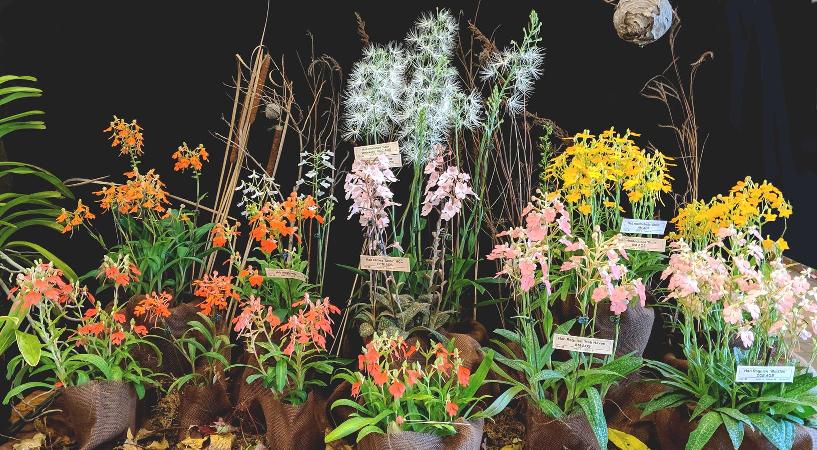
© 2019 Katie Payeur
Probably the best Habenaria exhibit of all time, "Hab Haven" display by Joel R. Edwards at the Illinois Orchid Society Show (Chicago Botanic Garden, Chicago, IL), October 12, 2019, awarded an AOS Artistic Certificate and Show Trophy. The notes for the award mention that the display contained ten species and hybrids on a 30" × 60" tabletop. However, the clerks on the judging team got off easy; they did not count the flowers or take measurements — apart from those of the tabletop and for the AM/AOS awards for two of the plants.
